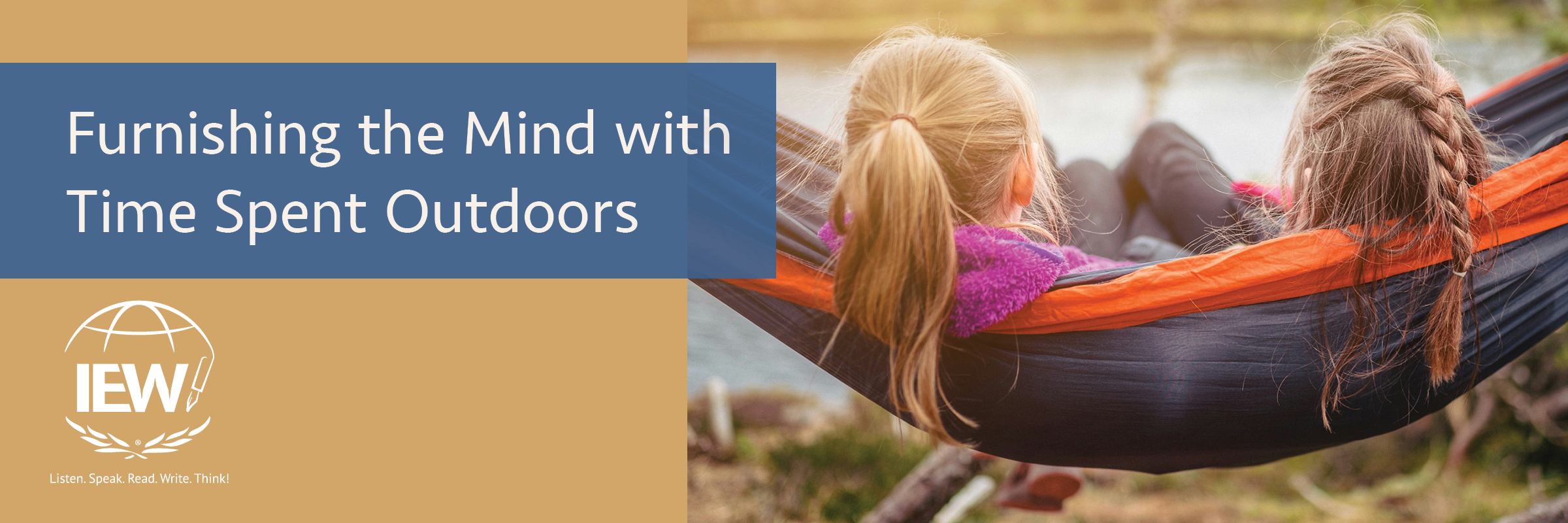
“Live in the sunshine, swim in the sea, drink the wild air” (Ralph Waldo Emerson). Spending intentional time outside provides many benefits, including building writing skills. In a recent podcast, Andrew Pudewa discussed how being outside furnishes the mind. He reminded listeners that they can’t get something out of a brain that isn’t in there to begin with. How can students write about the texture of bark or the color of a sunset if they are not regularly observing these things? Spending time outdoors furnishes the mind with patience, the ability to reflect, and a bank of images, textures, and sounds that might just creep into their writing when they least expect it.
Spending time outside furnishes the mind with the ability to reflect and observe and wonder. Being outside reminds us to slow down and notice things. While nature can move quickly, like a storm that blows through, nature often moves slowly. Watching nature requires patience because it takes time for a bud to open, for a butterfly to emerge from a chrysalis, or for a leaf to travel down a stream.“Rivers know this: there is no hurry. We shall get there some day” (A.A. Milne, Winnie-the-Pooh). Even toddlers will stop to watch an ant cross their path. How often do you sit outside for even a few minutes without anything distracting you? In the podcast, Andrew challenged listeners to spend time outside without a phone to record the sunset or a podcast to occupy the time. Allow yourself some time this summer to be outside and look for wonder.
My family may not be diehard hikers or wilderness campers like some of our friends, but we do try to enjoy the lovely Michigan summers by spending time outdoors. We have an end-of-school-year tradition of spending a day at Sleeping Bear Dunes National Lakeshore. We hike the dune, bike the Dunes Trail, and wrap up the day with ice cream. Even my adult children try to make time to return for this. We also spend time at our local botanical gardens. Visiting often in the summer gives us a chance to watch what is blooming when, especially in the native wildflower garden. I’ve also created a personal list of county and state parks within an hour’s drive. While we won’t visit all of them, planning ahead means we are more likely to spend time outdoors.
Keeping a summer nature journal is a great activity, but some kids struggle with knowing how to write about what they are observing. If you want your children to write about their outdoor adventures, furnish their minds with word lists, such as A Word Write Now, IEW’s thematic thesaurus. The first section of the book includes words for character traits, but the second and third sections will really add to their writing about nature. These include lists for describing just about anything you could do or find outside: shape, appearance, color, size, textures, temperature as well as words for movement and the senses.
Another way to furnish minds with time spent outdoors is by reading books set in the great outdoors. On those rainy summer days, have a stash of books that celebrate being outside even when you can’t be. Let authors model how to write about nature. These are some favorites at our house.
Roxaboxen
Storm in the Night
Thundercake
The Bee Tree
Gone Away Lake
Swallows and Amazons
Brighty of the Grand Canyon
Kildee House
My Side of the Mountain
Hatchet
Do you need more book ideas? Download the IEW Book Recommendations list and look for nature titles. Read Aloud Revival also has a podcast episode that includes a downloadable nature study booklist. Enjoying and imitating great authors is an excellent way to furnish their minds with sophisticated language and sentence patterns.
Sometimes a book can even inspire nature play. When I was in college, I worked in the library. One summer, the head librarian invited all the student workers to a nearby park for a picnic and Pooh Sticks, a game taken from A.A. Milne’s House at Pooh Corner. Thus began a tradition that I’ve brought into my family. My children (now ages 25-14) cannot pass a footbridge without stopping to pick up a few sticks and toss them into the water. Are you looking for more inspiration and ideas for things to do outside? Have your children pick a few activities from this list of 50 things to do before you’re 11¾.
Do you have children who love to be outside but who are reluctant to read? I do! Maybe you have some who love to read but who don’t love to be outside. Look for ways to make reading and being outside enjoyable. Hammocks are popular right now, and all my children have asked for them for gifts over the past few years. Before sitting down to write this blog, I went looking for my daughter and found her in her hammock slung between branches of the tall maple tree at the edge of our yard, listening to an audiobook and working on a sewing project. It’s a win-win when you can find something that encourages multiple ways of furnishing the mind.
One of the simplest and most refreshing ways to furnish the mind is to spend time outside. While some of these ideas require planning, you can simply grab a blanket (and maybe some bug spray and sunscreen) and sit for a while in the grass, soaking up sunshine and refreshing your soul. “Always be on the lookout for the presence of wonder” (E.B. White).
by Danielle Olander
